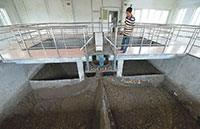Downpours expose loopholes in disaster response
(Xinhua) Updated: 2012-07-24 06:51BEIJING - Although the Beijing government had issued warnings, residents in the Chinese capital were still caught off guard by Saturday's rainstorm that left 37 people dead.
The rainstorm, purportedly the worst in 60 years, hit Beijing on Saturday.
Two days after the deadly rainfall, rescue workers are still trying to clear water on a section of the Beijing-Hong Kong-Macao expressway, where more than 80 automobiles were submerged in up to 6-meter deep of water.
The downpour and the following devastating flooding exposed many loopholes in the city's disaster response.
A few days before the rainfall, the Beijing Meteorological Bureau had forecasted the rainstorm.
However, few people would have imagined the casualties the rainfall would cause, and no substantial precautionary measures had been taken.
After the rain started, the weather bureau issued a "blue" warning for heavy rain. It then upgraded the warning from "blue" to "yellow" at 2 pm, hiking it even higher to "orange" at 6:30 p.m.
Yet few understand what the four-tier color-coded weather warning system exactly means.
Some have argued that the warnings are of little use if they can not be delivered to those in need.
A Chinese writer, Zheng Yuanjie, questioned on the Twitter-like Sina Weibo, why authorities did not inform people of the possible danger through the mobile phone networks.
In response to the inquiry, Qu Xiaobo, deputy director of the Beijing Meteorological Bureau, told a press briefing on Sunday that it was technically impossible to send short messages within a short time, as there are limited base stations in Beijing.
However, Qu's comments were denied by Beijing's major telecommunication companies, noting that there are no obstacles in sending short messages in mass.
Saturday's rainstorm also grounded hundreds of flights at the Beijing Capital International Airport. More than 500 flights out of Beijing were delayed and finally canceled, stranding about 80,000 passengers at the airport.
Beijing residents joined in efforts late Saturday evening to help transfer stranded passengers at the airport back to town.
Services of the fast-rail line linking the airport with the downtown area, however, were only extended one hour after it resumed operation at 10:05 p.m. after two and a half hours' suspension due to power failure.
Internet users also questioned why public venues like stadiums and theaters were not opened to accommodate those who were unable to return home due to traffic problems.
Beijing was not for the first time flooded by rainstorms. Almost the same time a year ago, a similar torrential downpour battered Beijing, inundating many lower sections of the roads and killing two people.
Unfortunately, last year's tragedy was not enough for the government to take more proactive measures this year.
Experts say there is big room for the authorities to improve in handling such kind of emergencies.
For instance, a command center should be established to coordinate various departments in dealing with disasters.
The latest flooding once again has brought people's attention to the drainage system, which has long been criticized as insufficient to cope with the rainfalls in recent years.
Many skyscrapers have been erected and densely-populated communities built in recent years thanks to a buoyant property market.
However, the drainage systems have not been upgraded accordingly and remain at a low standard, experts say.
Beijing's drainage system is able to withstand precipitation of 36 to 56 mm per hour. However, the city received 163.7 mm of precipitation on average as of 10 p.m. Saturday, the largest since weather records began in 1952.
It is high time for the government to work on the improvement of the drainage system so that such kind of tragedy will not happen again.
- CPC unveils major economic tasks to boost growth
- Advanced destroyers boost combat capability of PLA
- How apocryphal speech of Nobel laureate became a viral hit
- Delay 2nd baby, experts say
- China mulls court services in English
- CPC releases document to intensify political education
- Courts to improve services for ethnic litigants
- Air pollution jumped to alarming levels last month
- Officials admit to faking economic figures
- New anti-terror guidelines released







